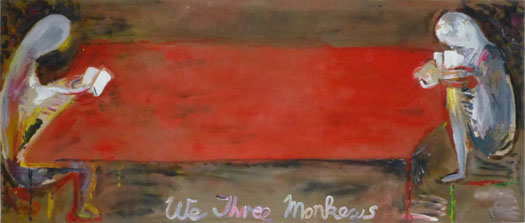Lesson 33
Do not dismiss the obvious
I have been criticised for being too obvious and not leaving enough space for the imagination of the audience. I used to tell my students not to discount the obvious, as the obvious can be difficult to deal with but it could be the fundamental, the common denominator, the important thing. You should not dismiss the obvious without investigating it thoroughly. The obvious is not always obvious. The problem with the obvious is that it can be invisible, it can be ignored, nobody gives it any thought; simply because it is obvious. Being obvious – or just being straightforward – is not the easy option and unfortunately, as I have pointed out before, for much of the time obscurantism wins the day.
I suppose there could be good obscure, like the unexpected, the curious?
Or is the obscure always mystification?
I think there is a difference with the obscure and the mysterious, the enigmatic or a contradiction, a paradox. Art often ‘holds’ contradictions and is ambivalent.
Art can be straightforward and accessible, yet still mysterious.
Can the obvious surprise? Can the obvious be unexpected? The obvious can be seen as a starting point; it depends what you do with it.
As the obscure can stand in for the mysterious and the enigmatic it can also substitute for originality. However, there might be a very good reason that nobody has written about this particular artist, or utilised this working method or style, simply because it is rubbish!
There is a desperate notion that ‘everything’ has been done and that pluralism and appropriation rule. Artists have always been determined to be original but in this present climate there is no need to even bother to invent anything new, just borrow or steal it, and so gimmicks are now employed, particularly used as a branding tool. What used to be referred to as a methodology has now given way to gimmicks. Gimmicks have never been to the point or straightforward: gimmicks are always beside the point! They are distractions.
The idea of being obvious and not leaving enough room for the audience presumes that looking is somehow indifferent, passive, and that it does not involve the active participation of the viewer. However, looking is not passive, but active, and the act of looking requires imagination. To look at a painting will always involve the imagination, it will always involve thinking. This is the difference between seeing and looking, hearing and listening.
It seems that today they have forgot how to ‘look’!
Didactic art is not popular these days as it seems to leave out the participation of the viewer. Making a statement was popular in the 1960s but this also goes against the grain with much current art practice.
There is nothing wrong with informing the audience, communicating an idea, being didactic, propagandist, or even being obvious. Of course you can can insinuate, imply or allude to and you needn’t knock people over the head with an opinion. Better still, you can ask a question, as to pose a question is a political act.
My painting of 1983 ‘We Three Monkeys‘ (based on the Japanese Three Wise Monkeys: ‘see no evil, hear no evil and speak no evil). This painting depicts two figures gambling, where the third monkey is the viewer, thus involving the audience psychologically in this folly. Implicating the viewer in this absurd predicament is a notion that nobody is innocent. This could be seen as involuntary audience participation, unwitting participation. They are involved whether they like it or not. The audience is involved and has to take responsibility. It is more powerful when the viewer gets the joke, when this realisation pops into their head whilst looking at the painting.
Maybe with artists such as Robert and Roberta Smith and Jeremy Deller, the fashion has changed and those particular ways of involving the viewers imagination have changed and didactic and propaganda work is once more the order of the day.
One of my portable art, anti-fascist banners in action during an anti-National Front demonstration, London 1976.
There is always space left for the imagination of the audience when looking is involved. The act of looking engages the imagination. Looking involves thinking.
At one level this insistence on leaving space for audience imagination is about the democratisation of art, the point being that everybody is an artist. However, the audience will see what they bring to the work. They will see what they want to see, they will bring their own baggage, preconceptions and prejudice to the work.
Art reinforces opinion, rarely changes opinion, rarely informs like literature. When reading I have often been told something new, but never thought standing in front of a painting, “well, I never knew that!“
This notion of art reinforcing already established views is central to the debate on didactic art: that is, whether or not art can change things. Changing always implies changing things for the better: I think art more often than not art tends to change things for the worse, by upholding the status quo.
Upholding the imagination of mediocrity.
Lesson 33: Do the obvious and communicate your ideas. Make a statement and be straightforward in your art, tackling problems head on. Avoid obscurantism. If the work is any good people will participate and get involved.
This entry was posted on Wednesday, December 7th, 2016 at 10:36 am
You can follow any responses to this entry through the RSS 2.0 feed.


